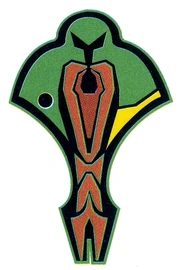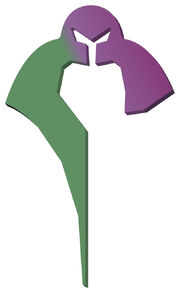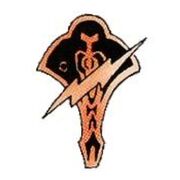- For other uses, see Galor.

Cardassian Galor Standard.
The Galor Banner (or the Cardassian Standard) is the symbol of the Cardassian Union. (DS9 novel: Day of the Vipers; DS9 reference: Star Trek: Deep Space Nine Technical Manual)
It is named for the Galor, a semi-mythical warrior-king. The Galor was greatly respected among his people for leading his army of masked shadow-warriors to complete victory on numerous occasions. His prowess in battle was respected and feared across Cardassia, as was his dark power of “magic”. Of course, the fearsome, powerful military politician was an image greatly inspiring to the Central Command. It is an even more appropriate emblem when one considers the Galor was originally also a religious figure; Central Command exterminated followers of the Cardassian church in order to establish itself as the supreme moral authority; citizens of the Union were then encouraged to identify with the state in an almost religious manner. Note that the Galor’s “eyes” are always watching and judging.
The Galor Banner resembles the Galor standing upright, dressed in the traditional cloak and mask of several obscure religions from ancient Cardassia. The figure is placing the symbolic mask upon his face, and he stands tall and straight, reflecting the ideals of strength and discipline. The Banner is not just one man, however; it also represents the Cardassian civilization as a whole, reminding those who view it that the ethical citizen lives only for the good of the state. The anatomy of the Galor thus corresponds to an abstract representation of Cardassian ideals. The “legs” are a pillar planted firmly in Cardassian soil, drawing strength up from the native land into the mask, while the cloak encompasses the sky, spreading the glory of Cardassia to the stars above. On one side of this widely-spread cloak/sky is a circular representation of the sun or moon- exactly which is no longer relevant, as the old moral binary of day and night has been replaced by the absolute morality of Central Command. On the other side is positioned a symbolic image of a weapon held under one arm. The cupped forearms placing the mask upon the face feature two layers, one inside the other, and are themselves “inside” the cloak, making three layers. This symbolizes the trinity of body, mind and soul; soul inside mind, mind inside body, all here dedicated to the greater good of Cardassia. The “legs” also feature three pieces, further reflecting the significance Cardassians place on that number.
Various institutions, professional organizations, and political subdivisions in Cardassian society use insignia representing a variation on the Galor Banner. That in use by the Cardassian Guard is menacing and dramatic, with a dark blood-red used in place of the traditional colours. Note also that where the standard banner depicts the figure in the process of placing the “mask” on his face, in the Guard variety it is fully attached, channeling his power and displaying it outwardly, in a manner that is also inviting, thanks to the deep black tone making it reminiscent of an opening. Essentially, it represents an aggressive challenge, as if daring the enemy to do their worst.

The Obsidian Order "obscured" Galor.
The insignia of the Obsidian Order is ghostly, seemingly incomplete and placed in silhouette, half hidden in the shadows. While it does encourage a sense of mystery and omnipresence, it is also intended to be a very concrete demonstration of the Order’s presence in Cardassian society. After all, despite operating in the shadows, the Order keeps its Headquarters in plain sight in the capital city.(DS9 novel: A Stitch in Time) Their presence is intended to be noticed; the Order would not have an insignia were it not. The symbol serves as a proud statement of the sacrifices the OO agent makes in the defense of Cardassia, surrendering their life piece by piece to the “secrets of the state”. It has no mask; it no longer needs one. (DS9 novel: A Stitch in Time) (ST novel: Well of Souls)

Shyak's death row banner.
The terrorist followers of the war criminal Gul Shyak used a variation of the Galor as their insignia. These terrorists, who were culled from the ranks of escapees from Bajoran execution centers, used the symbol given to them by the Bajoran prison system - a Galor banner with a jagged bolt crossing the symbol. Kira Nerys recognized the mark from her time in the Bajoran Resistance, when she recommended death sentences for such offenders. (DS9 comic: "Turn of the Tide")
